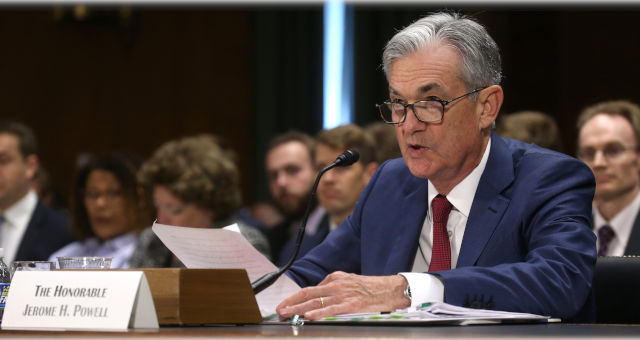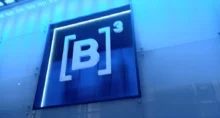Veja transcrição completa da conferência de imprensa de Jerome Powell

Diante da importância da comunicação entre banco central e mercado, o chairman do Federal Reserve, Jerome Powell, concedeu entrevista coletiva nesta quarta-feira (31).
A decisão histórica de cortar o juro pela primeira vez desde 2008 era amplamente esperada pelo mercado.
O foco dos investidores agora reside na sinalização de afrouxamento monetário a frente.
Confira vídeo da entrevista de Powell:
Confira abaixo transcrição completa:
Jerome Powell: Good afternoon and welcome. We decided today to lower the target for the federal funds rate by a quarter of a percentage point to 2% to 2.25%. The outlook for the U.S. economy remains favorable and this is designed to support that outlook. It is intended to ensure against downside risks from weak global growth and trade uncertainty to offset these factors they are having on the economy and to promote a faster return to the 2% objective.
All of these objectives will support achievement of our overarching goal to expand our job market for the benefit of the American people. We also decided to conclude the runoff of our securities portfolio in August, rather than September as previously planned and I will discuss the thinking behind the interest rate reduction and the path forward.
The unemployment rate was below 4% and inflation had been running near the 2% objective for nines month. Our interest rate targets was at the low end of neutral. Over the first half of the year, the economy grew at a healthy pace and job gains pushed to a near half century low. People who live and work in low and middle-income communities tell us many who struggled to find work are getting opportunities to add new and better chapters to their lives. This underscores the importance of sustaining the expansion so the strong job market reaches more of those left behind.
Through the course of the year, weak global growth, trade policy uncertain has prompted the FOMC to adjust the appropriate path of interest rates. The committee move from inspected rate increase to a patient stance of any chance and to today’s action. The median committee participants assessments have also declined this year. Reinforcing the case for a somewhat lowerWe expect job growth to be slower than last year but above what is required to hold the unemployment rate steady.
GDP growth came in close to second expectations. Consumption supported by rising incomes and high household confidence is the main engine driving the economy forward. Manufacturing output has declined for two consecutive quarters and business executives fell in the second quarter. In response to this weakness, many central banks are increasing policy accommodation or contemplating doing so. After simmering earlier in the year, trade policy tensions nearly boiled over in June, but appeared to return to a simmer. Our business contacts tell us the ongoing uncertainty is making some businesses cautious about their capital spending.. The deflation shortfall has continued. Core inflation, which is a better gage of future developments than total inflation has run 1.6% over the past 12 months. We continue to expect inflation will return over 2% over time. Domestic inflation pressures remain muted and global pressures persist.
Wages are rising, but not at a pace to put much pressure on inflation. We’re mindful that inflation’s return to 2% may be further delayed and continued below inflation could lead to a worrisome and difficult to reverse downward slide in expectations.
Taking all of that onboard, the committee sees a favorable baseline outlook. Over the year, however, incoming information on global growth, afraid policy uncertainty and muted inflation has caused to lower the path of interest rate that would best support that outlook. Today, we judge those factors warrant the policy adjustment I described.
As the committee contemplates the future path of the target range for the federal funds rate, it will monitor the incoming information for the economic outlook and act appropriately with a strong inflation for a 2% objective. Thank you. I am happy to take your questions.
Reporter: hi, Gena with The New York Times. Part of your statement here, I guess the question is, is there any reason to believe a 125 basis point — 25 basis cut point will be returning to your 2% target and if not, what is the hurdle rate there?
Jerome Powell: I think you have to look at not just the 25 basis point cut but the committee’s actions over the year. As I noted in my opening statement, we started off expecting rate increases, we moved here. I think what you have seen over the course of the year, as we move to a more accommodated policy, the economy has performed just about expected with that gradually increasing support. I wouldn’t take credit for all of that, but increasing policy support has kept the economy on track and kept the outlook favorable.
In terms of the rest of your question, the committee is really thinking of this as a way of adjusting policy to an accommodative stance to furtherer the three objectives that I mentioned, to ensure downside risks, provide support to the economy that the factors — where the factors are pushing down on economic growth and to support inflation. We do think it will serve all of those goal, again, we’re thinking of it essentially in the nature of mid-cycle nature to policy.
Reporter: Michael from Bloomberg television and radio. There is a perception throughout that perhaps in this case the Fed is in search of a hammer and a nail. The consumer reports that you suggested don’t show any demand problem in the U.S. When you look at mortgage rates, auto lending rates have come down. I’m wondering what exactly problem lower capital costs will solve?
Jerome Powell: So you’re absolutely right. The performance of the economy has been reasonably good. The position of the economy is as close to our objectives has it has been in a long time. The outlook is also good. What we have been monitoring is downside risks to the outlook from weakening global growth and we see that everywhere. Weak manufacturing, particularly in the European Union and China. We see trade policy developments at times has been disruptive and less so and inflation running below target. We see those as threats to what is clearly a favorable outlook and we see this action as designed to support them and keep that outlook favorable and frankly, it is a continuation of what we have been doing all year to provide more support against those very same risks.
Reporter: the follow-up question is how do they do that? How do cutting interest rates keep that going since the cost of capital doesn’t seem to be the issue here?
Jerome Powell: I really think it doesn’t. I think the evidence of my eyes tell me our policy does supports confidence, economic activity, household and business confidence and through channels we understand. It will lower borrowing costs and it will work. I think you see it since, you know, since we noted our vigilance about it in June. You saw financial conditions move up, I won’t take credit for the whole recovery, you see financial conditions go up, you see economic activity on a healthy basis. It seems to work through confidence channels, as well as the mechanical channels you are talking about.
Reporter: hi, Heather long from “The Washington Post.” You always say the Fed is data dependent and much of the data has a surprise to the upside or been in line with expectations. Can you give us a sense of how that, better than expected data impacted the FOMC’s thinking and if we keep seeing the upside surprises does that change or evolve any FOMC thinking going forward?
Jerome Powell: Yes, I think we, of course, what we do at every meeting, as I noted is we do a deep dive into U.S. economic activity and global activity and certainly carefully went through U.S. economic activity, which has been some positive and some negative, again, the issue is more the downside risks in the shortfall of inflation and we’re trying to address those, so in addition, going forward I would say, we are going to be monitoring the same things. We’re monitoring the evolution of trade uncertainty, global growth and low inflation and we’ll also be, of course, watching the U.S. economy. As I mentioned it showed resilience to those issues and we’ll put all of that together and that is how we’ll think about policy going forward.
Reporter: I just want to follow up on that. Would you say we’re sort of, you guys have gotten into a new regime here. This is sort of an insurance cut and not a data dependent cut, are we in the realm of watching headlines of trade talks other than watching job numbers and inflation numbers? How do we know what you’re going to do next and why in this new regime?
Jerome Powell: I gave three reasons what we did to ensure downside risks for global risks and trade tensions and that is a risk management point and a bit of an insurance. We also feel like weak global growth and trade tensions are having an effect on the economy. You see in the second quarter, you see weak investment and weak manufacturing so support for demand there and also to support return of inflation to 2%. Trade is unusual. We don’t — the thing is — there isn’t a lot of experience in responding to global trade tensions, so it is a something that we haven’t faced before and we’re learning by doing. It is not exactly the same by watching global growth where you see growth weakening. You see global banks responding with fiscal policy and growth strengthening and a business cycle. With trade tensions, which we do have a significant effect on the economy, they evolve in a different way. We have to follow them, by the way, I want to be clear here. We play no role in assessing or evaluating trade policies other than as trade policy uncertainty has an effect on the U.S. economy in the short and medium term. We are not criticizing trade policy that is not our job.
Reporter: thank you. Nick from the “Wall Street Journal.” So you and your colleagues offered three reasons to cut rates, a lower neutral rate that may have made the rate tighter, the global slowdown and the desire to recenter expectations, which of those factors, if any, weighs most heavily on you? More importantly, as a quarter point cut really going to address all of that, let alone any one of those?
Jerome Powell: So I think different people have different waitings. You mentioned lower all-star trade slowdown and I would actually add lower natural rate of unemployment has moved down, all of which point to more accommodation. Again, I don’t think asking about a quarter point is the right question. I think you have to look back over the course of the year and see the committee moving away from rate increases to a neutral posture to now a rate cut. I think we have been providing and that affects the financial conditions and affects the economy. You see an economy, which is performing pretty well, growth in the first half of this year is about the same as it was all of 2018 and actually a little better of our forecast for growth at the end of 2019. I think in a way that is monetary policy working and, again, I wouldn’t just look at the 25 basis point cut as the right question.
Reporter: I guess in May it seemed you had a higher bar to cut rates. In June you seemed to suggest if it didn’t improve, there might be a rate cut. Where is the bar right now because I think there is confusion about how the committee is responding?
Jerome Powell: Yeah, so we, um, as we noted, we noted at the bottom of the statement that language that says how we’re thinking about it. It says as we’re contemplating the future path of the target range, the future funds rate, we will monitor incoming information. It talks about that language. I can’t — all I can tell you is we will be looking at weak global growth. We will be looking carefully to see how that is happening. You learn every cycle you learn about these things. We will see whether growth is picking up, whether it is bottoming out. We’ll see on trade. We’re going to be seeing — I think we learned a lot on trade in this cycle and we will continue to learn more. In addition, the U.S. economy itself. The performance of the U.S. economy will enter into that. I would love to be more precise, but with trade, it is a factor that we have to assess in a new way those are the things we’ll be looking at and making our decisions going forward.
Reporter: Edward Lawrence with fox business network. A rate hike last December was seen by some economists and the Fed president as a step too far. Now the Fed waits seven months for a rate done. Could some of the weakness on the business side with that fixed investment and the sluggish side on the business side because the Fed waited so long? I want to get your thoughts on that and why you feel this nudge is the right level.
Jerome Powell: We don’t hear that from businesses. They don’t come in and say we’re not investing because the federal fund rate is too high. I haven’t heard that from a business. What we hear is demand is weak for their products. You see manufacturing being weak all over the world. Business investment is weak. I wouldn’t lay all of that at the door of trade talks. There is a global business cycle happening with manufacturing and investment and that has been, you know, definitely a bigger factor than certainly we expected late last year. I think global growth started to slow down in the middle of last year, but that has gone on to a greater extend. Trade policy uncertainty has been more elevated than we anticipated. In terms of this is — we believe this is the right move for today and we think it is — we think it will serve the three ends that I mentioned and I have already gone over how we’re thinking about going forward.
Reporter: you called it a midst cycle policy. What should we take this to mean and what message do you mean to send with this move today about future rate moves?
Jerome Powell: That refers back to other times when the FOMC has cut rates in the middle of a cycle. I am contrasting it there with the beginning, for example, the beginning of a lengthy cutting cycle.
Reporter: so we’re not at the beginning of a lengthy —
Jerome Powell: That is not what we’re seeing now. That is not our perspective now or outlook.
Reporter: hey, there. Are there any circumstances under which you would decide to pause — pause at one interest rate cut in today’s interest rate and not go ahead with further monetary easing at this stage or are you predicting, you know, once you have embarked on this easing, you will have to at least move by one more notch going forward?
Jerome Powell: So our policy will depend on the implications of the incoming data on economic outlook, as well as evolving risks to the outlook. We are going to be monitoring incoming information for the outlook, as I mentioned. I — that is really where I will leave it with that.
Reporter: hi, Victoria with Politico. On capital, vice chairman quarrels says the level of capital requirements that exist right now it is like the capital buffer is already turned on and he would like the ability to turn it down in a downturn. I wonder if you agree with that and then also, just quickly on real time payments. Larger banks suggested if the Fed built its own system that would be a bait and switch because the private sector called for a private sector. Is that a fair assessment?
Jerome Powell: First, I view the level of capital in the system being about right. I do agree with that. The idea that your talking about is one that is Vice Chair has talked about. It is under consideration. The idea being in the sense, we have chosen in the United States to have high through the cycle capital requirements by doubling the surcharge, which is the surcharge that the largest banks have. We have already put in place counter sickry call buffers and I’m not saying it is the same thing as a counter sickry call counter buffer. We don’t rely — our system doesn’t rely on our ability — doesn’t mainly rely on the ability to identify the right time in the trigger to counter a resickry call tool. Think is a good thing to do.
The idea of putting it in place so you can cut it that is something other jurisdictions have done and it is worth considering. I think the United Kingdom has a counter resickry call and you can cut when there is a downturn and give the banks more room. This is not something we have considered to do.
The United States is far behind in other countries in terms of having real time payments available to the general public. The Fed coming out of the reserve system, the reserve banks and the Board together convened all of the stakeholders around the table to talk about how we can move forward. This is consumer groups, banks, card companies, all of the groups that would be interested and worked on a project for several years and one of the things that came out of that was a recommendation that the Fed should build a 24/7/365 proposal to solve it. We got quite a lot of comments that were overwhelmingly favorable. Until our payment system in my places the Fed works alongside wholesale payments so it would not be unusual or out of keeping with how we have done things in the past. We have not made a decision on this, but it is something we’re looking at carefully and something I do expect we will make a decision on soon.
Reporter: Alfred Torres from Bloomberg. I’m trying to parse what you’re saying here. On the one hand, you say the policy tilt in the statement will ease financial conditions and that is helping the economy. That tilt and participants will interpret this language as interpret it as appropriate. On the other hand, you say it is not the start of an easing cycle. So what are you saying? Does that mean with one or two more cuts you will be done and the policy bias comes out of the statement or this policy bias will come out of the statement sooner than market participants think?
Jerome Powell: It is going to depend on the evolving data and the evolving risk picture. As we look at the situation now and the outlook now, what we see that it is appropriate to make an adjustment in policy to a somewhat more accommodated stance that is what we’re seeing and that is what we are going to be looking at incoming data at the risks that I mentioned and the performance of the U.S. economy and low inflation, we will be looking at that to make our decisions going forward.
Reporter: thank you, Mr. Chairman. You talked a number of times about the people who feel like they are just recently getting to the punch bowl 10 years into the expansion. Can you elaborate a little bit about how this rate cut is expected to help them?
Jerome Powell: I think the best thing for people who are feeling that and we are getting lots of feedback from people who work and live in low and moderate income communities that they are feeling the effect better than they have in anyone’s memory. This is great to hear. The best thing we can do is Exodus tent the expansion. There is no reason why the expansion can’t keep going. Inflation is not trouble living high. If you look at the U.S. economy right now there is no sector that is booming and therefore might bust. You have a fairly well balanced in a tense economy. The engine is consumer economy, which is 70% of the economy. The investment and manufacturing part of the economy is more or less not growing much. it is at a healthy level but not growing much, and we hope to help that with this rate cut. Overall, we’re trying to extend the expansion and keep close to our statutory goals, which are stable prices.
Reporter: Donna with CNN. The president repeatedly called for this rate hike and the Fed to end the runoff of its balance sheet. What do you say to those that the Fed gave in to what the president wanted today and can you elaborate on why the Fed decided to speed up the balance sheet runoff two months earlier today.
Jerome Powell: I gave my reasons — our reasons really for doing this and, you know, just to touch on that again, this action is designed to ensure against downside risks from weak global economy and trade tensions and getting closer to the inflation of 2%. That is what we have been talking about all year long and we have moved our policy in accommodation. You have seen an economy that reacted well to that, so that is why we’re doing it. We never take into account for political considerations. We don’t conduct monetary policy to prove our independence. We conduct monetary policy in order to move as close as possible to our statutory goals, which is what we’re always going to do. We’re always going to use our tools that way and at the end, we’ll live with the results.
In terms of the balance sheet that was really just a matter of simplicity and consistency and nothing more to it than that.
Reporter: Thank you, chairman Powell. I was wondering, we were not in the room, but I think it is a fair assumption to note that the two descenders spoke about financial concerns. I wonder for you can talk about what was your response to them when those concerns were raised. The financial bank of investment and settlements, when you have raise rates, it makes it harder to recovery in the economy.
Jerome Powell: I understand those concerns very well. I do. I have studied them and spoken about them and I take them seriously. As I look at today’s situation, I don’t see them as a reason not to take this action today. I don’t think, that would be my point, one of the reasons why I think that is if you look — so we have a financial stability framework for the first time. Before the crisis, we did not have this and now we publish it and we look at four big things, so the public can hold us accountable and compare us meeting to meeting and see if we get this right. We look at evaluation pressures and we do see notable evaluation pressures in some markets, but obviously not at a highly troubling level. In terms of household borrowing and household business borrowings, household borrowing is doing well. Funding risk is low. Overall staff’s view has been if you look at overall financial stabilities are moderate. The place that gets all of the attention is business borrowing and we look very carefully at that. What has happened with business borrowing is the loans moved off of the balance sheets of the banks and into market-based vehicles, which tend to be stably funded, but nonetheless, it is clear a highly leveraged business sector could act as an amplifier to the downturn and we’re watching that carefully. Again, I can give you a look at the system and it has high resilience and that gives us the ability to use monetary policy for its purposes and rely on supervisor and regulatory tools to keep the financial system resilient.
Reporter: so your not doing something today to help today and then it is going to cause problems down the road? You’re not worried about that kind of dynamic?
Jerome Powell: There are few things I don’t worry about at all. Of course, we monitor. Every quarter we have an extensive briefing on financial stability and we had that yesterday. We look at this on an ongoing basis. We have a great team. We are more very much monitoring these things all of the time. We worry about this all of the time. We’re looking for that thing that we may have missed a lot of the time. The things we haven’t missed, I think they paint a mixed picture, but not one that should prevent us from taking monetary policy actions that we think are appropriate to support the economy.
Reporter: Marty, A.P. you talked in this press conference about being data dependent going forward and this is not the start of a rate cut. Financial markets think this is a series of rate cuts and they are predicting three or four cuts this year. Is this your effort to damp down that?
Jerome Powell: It is not the beginning of a long series of rate cuts. I did not say it was just one. When you think about rate cutting cycles they go on for a long time. The committee is not seeing us in that place. You would do that if you saw real economic weakness and you thought the federal funds rate needed to be cut a lot that is not what we’re seeing. What we’re seeing is it is appropriate to adjust policy to a somewhat more accommodative stance overtime and that is how we’re looking at it. It is not long cutting recycle, that is what we do when there is a recession or long downturn that is what I’m ruling out. When you look at other mid-cycle adjustments you see, I don’t know if they will be comparable or not, but you will see examples of these.
Reporter: Don with the L.A. times. You mentioned the difficulty of assessing trade tensions in the economic outlook. Could you say how much of a factor the U.S.-China trade conflict was in the Fed’s decision to cut rates and if the current stalemate and the threat of more tariffs continue, what would that mean for future interest rates and possible cuts?
Jerome Powell: You know I wouldn’t bring it down to any one trade thing or one factor. I think we look at a broad range of factors and trade policy uncertainty includes the discussion with China. I wouldn’t be able to tell you how much is due to that. Without knowing, with trade we have to react to the developments and they don’t know what they will be, so it is hard to exactly say. It is certainly, we have seen though when there is a sharp confrontation between two large economies, you can see effects on business confidence pretty quickly and financial confidence pretty quickly but then we saw that unwind. You see it returning to a lower temperature, I think. With trade policy we will be watching and trying to assess the implications for the U.S. outlook.
Reporter: [inaudible]
Jerome Powell: The mechanicals of the tariffs are small, they are not large when it relates to the U.S. economy. The real question is what is the effects through the business confidence channel and again, very, very hard to tease that out. I have seen research, which says they are meaningful effects on output. As to say not trivial and I think that sounds right, but it is quite hard — there is no way to get an accurate measure. You have to look at a range. Businesses will tell you it is a factor, particularly manufacturing businesses that have supply chains that cross international borders. Many have made adjustments and have got on the a place where it is OK, but it has been a challenge.
Reporter: Paul from news wire. Thank you for the question, chairman. As the press conference, is this press conference has gotten underway, markets declined, the Dow is down as much as 400 points. What I’m hearing is a reluctance to provide more guidance around the future path of rates and I’m wondering if that reflects a greater lack of consensus on the committee and, you know, how much consensus do you want to see around these decisions and how split are people about this?
Jerome Powell: You’re right. There’s a range of view tops — of views on the committee, but the committee is completely unified to making the best policy decisions we can make and that means people have the responsibility to do their best thinking and present that thinking and I wouldn’t have it any other way.
In terms of the way forward, we will be monitoring the factors that I mentioned and we lay that out, you know, in the post meeting statement and that is the roadmap we will be following. We are going to be data dependent. We are going to be, as we always are, doing what we need to do to support the economic expansion.
Reporter: John with American banker. It has been about 18 months since the Fed issued the enforcement action against Wells Fargo. I’m wondering if you could characterize the progress the bank has made in its short coming in the risk management and I’m curious if their lack of a permanent C.E.O. has hampered progress in your eyes?
Jerome Powell: The problems that arose at Wells Fargo around risk management and consumer, the way they dealt with the consumer work were pretty deep and I think the company realizes that and they are not going to be fixed — they haven’t been fixed quickly and frankly, we did not expect them to be fixed quickly. They will be under the growth cap in our enforcement action until the Board votes to lift it and that is not something we are considering doing right now. The company is working away to address these issues, but as I said, they are deep seeded issues and it takes time to address them. I wouldn’t comment on the C.E.O. question. I don’t have anything for you on that.
Reporter: are you pleased with the responsiveness you are getting from them? Is this going the way you want it to?
Jerome Powell: I’m not going to characterize it. I have characterized it, we have policy in place, the company is working away and they are taking it seriously. They see it has something that has to go deep and we’ll lift the growth cap when we’re satisfied.
Reporter: I’m with marketplace. When we have the next recession, the Fed will have less room, it will happen, the Fed will have less room to maneuver to cut interest rates than you have now, how big of a problem will that be?
Jerome Powell: I will question your premise for a second. If you remember, again, one of the purposes of our cut today is to support the expansion and we don’t know when — if it really works, if it works really well and the economy gets going again, you don’t know where the funds in other cycles and I don’t know if this will happen again, the Fed rose rates after a mid-cycle adjustment. Again, I’m not predicting that, but I don’t think we know we’ll have less ammo because of these things, that is one thing.
Reporter: you won’t be able to cut as much if rates are low and you will have less ammo in that sense.
Jerome Powell: But you’re assuming we would never raise rates again. Once we cut the rates they will never go back up, as a matter of principle, I don’t think that is right. In long U.S. business cycles have sometimes evolved this event where the Fed will stop hiking and in fact cut and go back to hiking. I don’t know if it will happen here. It doesn’t seem like something that is particularly likely. We don’t know that and I think by extending the cycle, you do have a lot of benefits from that and I think we will use the tools we have, a couple of rate hikes one way or the other is not going to matter so much. If there is a downturn, you’re right there will be one, we will use all of our tools aggressively when the time comes.
Reporter: hi, Jean Young. Can you give us an update on the reassessment inflation framework and have the discussions so far this year have any bearing on today’s decision?
Jerome Powell: So the monetary policy review is really for — it is there to look at the way we make policy in the longer run. It is not something that enters directly into our discussions today. So far we have had a series of meetings called the Fed listens and it will be at all of the reserve banks and we meet with the constituents that we serve and they have been successful hearing from people, not just economists, but people who are not economists how their lives interact with the Fed’s work. It has been great. I got to say it has been better than I hoped it to be. We are just now beginning the process to incorporate that feedback and we’re going to have a series of meetings beginning today as we evaluate the questions about our framework. It is very early to say where that is going, but we’re setting the table now and looking at what the framework is and looking at how all frameworks performed around the world during the global financial crisis. I expect we will be at this for a while. I’m excited about it. I think it has been a good exercise. I think it has opened us up to sunlight and perspectives that we might not have gotten otherwise. I think it is a good time. You have 10 years after the crisis. You are living in a new normal for the economy and monetary policy and it is a good time to step back and ask whether there are things we can do to improve our framework.
Reporter: hi, Mr. Chairman. Courtney Brown. Can you give us a sense if the committee feels constraints at all from the markets with more cuts or in other financial markets?
Jerome Powell: I think this was well telegraphed. I mentioned the reasons for it and they have been well telegraphed and I think they will achieve their goals. Monetary policy works through communication and actions that are sensitive to those communications and we think the changes we made this year have really worked. We maintain the flexibility to adjust our actions in light of the incoming data and the risk picture, but I will leave it there, yeah.
Reporter: Brian with yahoo finance. To expand on that point about financial markets, John William’ remark before the blackout period, so the Fed added language in the statement that says the committee is contemplating the future target path as it monitors implications. I’m wondering there is an inflection point of whether or not the downside risks because you cut rates outweighs the fact that you see a positive outlook of the U.S. economy at a baseline? I am wondering if you can clarify those things in the challenge of communicating it.
Jerome Powell: I see the U.S. outlook of being a positive one. We do — we have had the global really risks to the outlook. There is nothing in the U.S. economy that presents a prominent near-term threat to the U.S. economy. As I mentioned there is no segment that is or sector that is boiling over and heating. Nothing like that. It is within the economy, it is healthy. I would say that. Downside risks are coming from abroad and we are concerned about low inflation and, by the way, the risks from abroad are affecting the manufacturing here and fixed investment, so. Thank you.




![[Conteúdos gratuitos] Assista ao Giro do Mercado e outros programas exclusivos em nosso Youtube](https://www.moneytimes.com.br/uploads/2024/01/banner-html-28.png)








